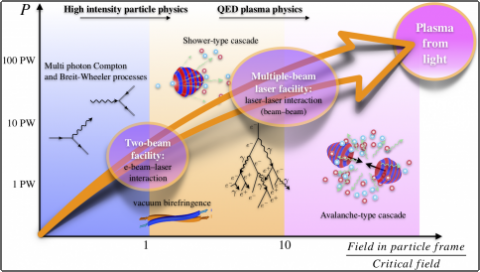P. Zhang, S. S. Bulanov, D. Seipt, A. Arefiev, and A. G. R. Thomas, "Relativistic plasma physics in supercritical fields", Phys. Plasmas 27, 050601 (2020).
Since the invention of chirped pulse amplification, which was recognized by a Nobel Prize in physics in 2018, there has been a continuing increase in available laser intensity. Combined with advances in our understanding of the kinetics of relativistic plasma, studies of laser–plasma interactions are entering a new regime where the physics of relativistic plasmas is strongly affected by strong-field quantum electrodynamics (QED) processes, including hard photon emission and electron–positron (e−–e+) pair production. This coupling of quantum emission processes and relativistic collective particle dynamics can result in dramatically new plasma physics phenomena, such as the generation of dense e−–e+ pair plasma from near vacuum, complete laser energy absorption by QED processes, or the stopping of an ultra-relativistic electron beam, which could penetrate a cm of lead, by a hair's breadth of laser light. In addition to being of fundamental interest, it is crucial to study this new regime to understand the next generation of ultra-high intensity laser-matter experiments and their resulting applications, such as high energy ion, electron, positron, and photon sources for fundamental physics studies, medical radiotherapy, and next generation radiography for homeland security and industry.
